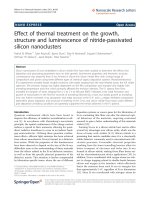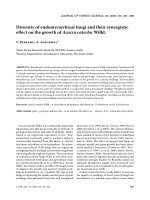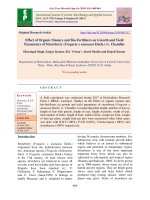Effect of organic manure and spacing on the growth and yield performance of baby corn under poplar based agroforestry system
Bạn đang xem bản rút gọn của tài liệu. Xem và tải ngay bản đầy đủ của tài liệu tại đây (157.53 KB, 5 trang )
Int.J.Curr.Microbiol.App.Sci (2018) 7(3): 3015-3019
International Journal of Current Microbiology and Applied Sciences
ISSN: 2319-7706 Volume 7 Number 03 (2018)
Journal homepage:
Original Research Article
/>
Effect of Organic Manure and Spacing on the Growth and Yield
Performance of Baby Corn under Poplar Based Agroforestry System
Ayush Bhushan* and Neelam Khare
Department of Agroforestry and silviculture, College of Forestry SHUATS, Allahabad, India
*Corresponding author
ABSTRACT
Keywords
Spacing,
Vermicompost,
Poplar, Baby corn
Article Info
Accepted:
24 February 2018
Available Online:
10 March 2018
Present investigation was under taken to study and compare how spacing
influenced the performance and yield of two varieties of Baby corn under
poplar based Agroforestry system. Three different spacing patterns i.e.
45x25, 55x25 and 65x25cm were evaluated in two varieties, HIM-123 and
DHM-107 of Baby corn in two consecutive years i.e. 2014 and 2015.
Following seven parameters (Plant height, Crop growth rate, Collar
diameter (cm), Number of cobs per plant, length of Cob (cm), girth of cob
(cm) and cob yield (q ha-1) were evaluated. Spacing pattern of 55x25 gave
best results in both varieties in all the treatments investigated; organic
manure in the form of vermicompost was used in all the treatments. It is
interesting to know that spacing pattern of 65x25 gave the worst
performance in both the varieties.
Introduction
Agroforestry is a land use system, which
contributes pragmatically in all these spheres
to materialize the desired goals. The theme of
agroforesty centered around sustainability in
terms of economics (productivity and
profitability), ecology (environmental and
resource conservation) and social issues (food
security, health and safety) that make it an
unparallel land use system (Pandey, 2007).
Poplar (Populous deltoids) based agroforestry
system is adopted extensively by the farmers
on a commercial scale will play a significant
role to meet the economic, social and
environmental concern of the people. Poplar
has become the most preferred cash crop in
north-western states (Chauhan and Mangat
2006). Almost any crop (cereals, pulses,
vegetables, forage, fruit, vegetable crop etc.)
can be grown with it (Hymavathi et al., 2010).
Poplar wood is used in packing cases, hard
boards, sports goods, construction works and
as pulp wood and poles (Garima and Pant,
2017). Vermicompost is organic manure
produced by the activity of earthworms. It is
mixture of worm casts which are rich in macro
and micronutrients. The casts of earthworm
have several enzymes and some growth
3015
Int.J.Curr.Microbiol.App.Sci (2018) 7(3): 3015-3019
regulating substances. The average nutrient
content of vermicompost is much higher than
that of F.Y.M. Vermicompost contains
1.60%N, 5.04% P2O5 and 0.80% K2O with
small quantities of micronutrients. The C: N
ratio of vermicompost is much higher (1:16)
than that of F.Y.M. (1:30). The activity of
earthwarms is recognized as beneficial for the
improvement of soil physical condition and
plant growth (Das et al., 2017).
Baby Corn (Zea mays L.), belongs to the gram
family of Gramineae, and originated from
Central America. Baby corn is widely grown
in both tropical and subtropical regions of the
world.
Its grains, which serve as food, feed as well as
industrial
raw
materials
containing
carbohydrate in form of starch up to 80% and
crude protein up to 10% (Sridhar and Adeoye,
2003). Baby corn production can be increase
by solving few problems such as rapid
redection in soil fertility, failure to identify
and plant high yielding Baby corn varieties
and use of inappropriate plant spacing which
determine the plant population and the final
yield.
Yield potentials have usually been represented
in parts under the most favorable combination
of soils, climate and crop management in
certain places without considering spacing
which is a major factor in increased yield
potential of Baby corn. Increasing population
density remains the most effective way to
increase whole plant yield in corn will 13%
advantage. Narrow row spacing was found not
to have a negative effect on whole plant yield
and nutritive value (Boloyi, 2014).
Hence the present investigation was
undertaken to study the effect of organic
manure and spacing pattern on the growth and
yield of Baby corn under poplar based
agroforestry system.
Materials and Methods
The experiment was conducted at The Forest
Nursery,
College
of Forestry, Sam
Higginbottom University of Agriculture,
Technology and Sciences Allahabad (U.P.)
India. In this present research work the effect
of different spacing pattern (45x25, 55x25 and
65x25 cm) and use of organic manure
(Vermicompost) on growth and yield
parameters of Baby corn was studied. Two
varieties (HIM 123 and DHM-107) were
investigated in two consecutive years 2014
and 2015. Growth parameters such as plant
height, crop growth rate, collar diameter (cm),
crop growth rate, collar diameter (cm),
number of cobs per plant, length of cob (cm),
girth of cob (cm) and cob yield were studies
during the investigation. The data reordered
during the course of investigation were
subjected to statistical analysis as per method
of analysis of variance (Fisher, 1921).
Results and Discussion
Results obtained from the investigation
undertaken to study the effect of spacing
pattern (45x25, 55x25 and 65x25 cm) and
organic manure (Vermicompost) an growth
and yield parameters of the Baby corn plant in
2014 and 2015 are presented in Table 1 and 2
respectively.
Plant height
Plant height was significantly affected by
different spacing pattern. The tallest plants
were recorded of V2S2F in both years. In 2014
it was 97.20 cm, whereas in 2015 it was
103.27 cm. The shortest plants were observed
in V1S3F in both years. In 2014 was 85.80 cm
and in 2015 it was 91.07 cm. Among varieties
there is also variation in performance
regarding plant height, variety DHM-2017 is
the best performer in all the treatments
investigated.
3016
Int.J.Curr.Microbiol.App.Sci (2018) 7(3): 3015-3019
Table.1 (2014)
V1 S1 F
V2 S1 F
V1 S2 F
V2 S2 F
V1 S3 F
V2 S3 F
Interaction
(VxSxF) F
test
S. Ed. (+)
C.D at 5%
P.H
86.67
86.80
93.80
97.20
85.80
85.93
S
CGR
16.74
16.99
16.38
17.40
13.93
14.42
S
CD
1.82
1.92
2.47
2.68
1.33
1.42
S
NCP
2.33
2.40
3.13
3.53
1.87
1.93
S
LC
8.33
8.47
9.00
9.47
7.60
7.73
S
GC
2.40
2.47
3.07
3.60
1.87
1.93
S
CY
29.79
31.33
46.87
55.97
19.99
21.41
S
0.31
0.63
0.15
0.30
0.03
0.06
0.05
0.11
0.06
0.12
0.07
0.15
0.81
1.66
Table.2 (2015)
V1 S 1 F
V2 S 1 F
V1 S 2 F
V2 S 2 F
V1 S 3 F
V2 S 3 F
Interaction
(VxSxF) F
test
S. Ed. (+)
C.D at 5%
P.H
92.07
92.20
98.60
103.27
91.07
91.27
S
CGR
18.58
18.88
18.89
19.51
15.40
15.99
S
CD
2.13
2.27
2.93
3.13
1.47
1.60
S
NCP
2.53
2.60
3.33
3.80
2.00
2.07
S
LC
8.93
9.07
9.67
10.13
8.13
8.27
S
GC
2.60
2.67
3.33
3.93
2.07
2.13
S
CY
34.01
35.85
52.80
64.67
22.73
24.26
S
0.09
0.19
0.17
0.34
0.05
0.09
0.06
0.13
0.06
0.11
0.08
0.15
0.99
2.01
Crop growth rate
In both years 2014 and 2015 the highest CGR
was reordered in the V2S2F treatment. In 2014
it was 17.40 along with 16.38 of V1S2F. In
2015 it was 19.51 followed by 18.89 observed
of V1S2F treatment in 2014. The lowest CGR
was recorded in V1S3F (13.93) along with
14.42 of V2S3F.
Collar diameter (cm)
Variety DHM-107 is the best performer in
both the years of the experiment i.e. 2014 and
2015, under the spacing pattern of 55x25 it
shows 2.68 and 3.13 respectively. The
spacing pattern of 65 x25 is the worst
performer in both the years and in both the
varieties too.
Number of Cobs per Plant (N.C.P)
Number of Cobs per plant was significantly
influenced by the spacing pattern.
Maximum number of Cobs per plant was
observed in the spacing of 55x25 in both the
varieties, in the treatment of V2S2F (3.53 and
3.80) in both the years of investigation i.e.
2014 and 2015 respectively.
3017
Int.J.Curr.Microbiol.App.Sci (2018) 7(3): 3015-3019
Length of cob (cm)
In both the years 2014 and 2015 the
maximum length of Cob was observed in the
V2S2F treatment it was 9.47 and 10.13 in the
years 2014 and 2015 respectively. The
maximum length of Cob was observed in
V1S3F (7.60 and 8.27) in the years 2014 and
2015 respectively.
Girth of cob (cm)
Among the two varieties under investigation
it was clear from the data that variety DHM107 is the best performer in both the years. In
2014 the girth of cob was maximum in the
case of V2S2F (3.60) and minimum in the case
of V1S3F (3.93) and minimum in the case of
V1S3F (2.07).
and sunlight interception also increased (Reid,
2015). Boomsna et al., 2009 found that
decreased spacing declines the growth
parameters while (Sangoi et al., 2001)
observed that reducing spacing increased crop
yield and performance. Among the two
varieties studied it was quite clear by the data
that variety DHM-107 was the best performer
regarding all the parameters studied. There
might be few reason behind the difference of
the performance of these two varieties,
probably the vigour of the variety DHM-107
was better than HIM-123, the other major
reason can be the better use of climate
condition and better suited soil properties of
the experimental area. This is in agreement
with the findings of (Garima and Pant, 2017)
that there might be the difference in the
performance of different varieties sown in
same area under same climatic conditions.
Cob yield (q/ha)
The maximum Cab yield was observed in
V2S2F treatment. In 2014 it had 55.97 along
with 46.87 in V1S2F and minimum in V1S3F
(19.99). In 2015 it he was 64.67 along with
52.80 in V1S2F and minimum was recorded in
the treatment V1S3F (22.73) followed by
24.26 in V2S3F.
Among the three different row spacing pattern
it is quite interesting to know that in all the
characters studied in the investigation,
performance of treatment V2S2F (DHM107+55x25+Vermicompost) was best in
comparison to all other treatments, this might
be due to this reason that by increasing the
spacing from 45x25 to 55x25, the plant will
get adequate amount of nutrition, space and
water for its growth but as we increase the
spacing further to 65x25 the total yield
parameters were markedly reduced due to the
decreased number of plants. In the case of
45x25 spacing pattern due to the increase in
number of plants increased in a given area the
competition among the plants for nutrients
Spacing
significantly
affected
the
performance of both the two varieties studied
during the present investigation. Among the
three different spacing pattern studied the
performance of 55x25 was found to be the
best, followed by 45x25 and 65x25. Among
the two varieties studied variety DHM-107
has shown better performance in all the
parameters studied. So we will suggest the
farmers of the adjoining area of the
experimental area that they should follow the
55x25 spacing pattern and sow the DHM-107
variety for better performance.
References
Boloye. C (2014). Do row spacing and plant
density
influence
Baby
corn
productivity under reduced tillage. Arcgrain Corps influence. 23/02/2015.
Boomsme, C.R., Santini, J.B., Tollenaar, M.m
Vyn, T.J. (2009). Maize morphological
response to intense crowding and low
nitrogen
availability.
Agron.
J.
101:1426-1452.
3018
Int.J.Curr.Microbiol.App.Sci (2018) 7(3): 3015-3019
Chauhan, S.K. and Mangat, P.S. (2006).
Poplar based agroforestry is ideal for
Punjab, India. Asia-pacific Agrotorestry
News. 28:7-8.
Das, R.C. Somanagonda, G and Singh. B
(2017). Effect of integrate nutrient
management practices on growth, yield
and oil yield of safflower (Carthamus
tinctorius L.) Int. J. of Current
Microbiology and Applied Sciences, 6
(4): 511-516.
Fisher, R.A. (1921). On the mathematical
foundations of the oretical statistics.
Philos Trans. Roy. Soc. Landon Series
A- 222, 309-368.
Garima and Pant, K.S. (2017). Effect of
integrated nutrient management and tree
spacing on production potential of
maize (Zea mays) under poplar based
Agroforestry system. Int. J. Curr.
Microbiol. App. Sci. (2017) 6(8): 26922697.
Hymavathi, H.N., Kandya, A.K and Patel,
L.P. (2010). Beneficial effects of
multiple
plantation
pattern
in
agroforestry systems. Indian Forester,
136(4): 465-475.
Pandey, D.N. (2007). Multifunctional
agroforestry system in India, Current
Science, 92(4): 455-463.
Reid, D.C. (2015). Unbiased information on
nutrition benefits of food and home
remedies: health benefits of corn.
Organic information
Sangoi, L Ender, M, Guidolin, A.F. Almada
M.L. Heberte, P.C. (2001). Influence of
reduced spacing in corn yield in regions
with short summers. Braz. Agric. Res.
36(6): 861-869.
Sridhar, M.K.C. and Adeoye, G.O. (2003)
“Organic minerals fertilizers from urban
waste in the Nigeria field Vol 68, pp 91111.
How to cite this article:
Ayush Bhushan and Neelam Khare. 2018. Effect of Organic Manure and Spacing on the
Growth and Yield Performance of Baby Corn under Poplar Based Agroforestry System.
Int.J.Curr.Microbiol.App.Sci. 7(03): 3015-3019. doi: />
3019









